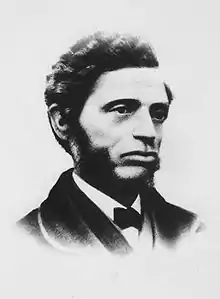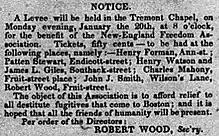

The New England Freedom Association (c.1842 – c.1848) was an organization founded by African Americans in Boston for the purpose of assisting fugitive slaves.
History
The New England Freedom Association was founded in 1842[1] or 1843,[2] and existed for about five years. Its founding members included William Cooper Nell, Henry Weeden, Judith Smith, Mary L. Armstead, Thomas Cummings, and Robert Wood. They raised "funds to aid those of our friends who flee to the land of the Pilgrims for their liberty."[2] Meetings were held in the African Meeting House on Beacon Hill.[3]
In December 1845, the association announced in the Liberator that it had reorganized.[4] Its officers were:
- President: Henry Weeden
- Vice-President: Joshua V. Smith (possibly a misprint for Joshua B. Smith)
- Corresponding Secretary: John S. Jacobs
- Recording Secretary: Thomas Cummings
- Treasurer: John P. Coburn
- Directors: James Johnson, Peter Avery, John St. Pierre, James L. Giles, James Scott, Mary L. Armstead, Judith Smith
Two of its twelve officers were women.[1] The Boston Vigilance Committee, by contrast, had no female members. In the Liberator article, the association described its purpose:
The object of our Association is to extend a helping hand to all who may bid adieu to whips and chains, and by the welcome light of the North Star, reach a haven where they can be protected from the grasp of the man-stealer. An article of the constitution enjoins upon us not to pay one farthing to any slaveholder for the property they may claim in a human being. ... Our mission is to succor those who claim property in themselves, and thereby acknowledge an independence of slavery.[4]
At least three of its members—John Coburn,[5] James Scott,[6] and John J. Smith[7]—took part in the rescue of Shadrach Minkins in 1850.
The Association eventually merged with the interracial Boston Vigilance Committee.[1]
See also
References
Citations
- 1 2 3 Quarles (1969), p. 153.
- 1 2 Nell (2002), p. 18.
- ↑ Jacobs (1993), pp. 175-176.
- 1 2 Nell, William Cooper; Weeden, Henry; Cummings, Thomas; Giles, James L. (December 12, 1845). "New-England Freedom Association" (PDF). The Liberator. p. 199.

- ↑ Snodgrass (2015), p. 367.
- ↑ Collison (2009), pp. 142, 195.
- ↑ Snodgrass (2015), p. 498.
Bibliography
- Collison, Gary Lee (2009). Shadrach Minkins: From Fugitive Slave to Citizen. Harvard University Press. ISBN 9780674029798.
- Jacobs, Donald M. (1993). Courage and Conscience: Black & White Abolitionists in Boston. Indiana University Press. p. 176. ISBN 978-0-253-20793-7.
- Nell, William Cooper (2002). William Cooper Nell, Nineteenth-Century African American Abolitionist, Historian, Integrationist: Selected Writings from 1832-1874. Black Classic Press. ISBN 9781574780192.
- Quarles, Benjamin (1969). Black Abolitionists. Da Capo Press. ISBN 9780306804250.
- Snodgrass, Mary Ellen (2015). The Underground Railroad: An Encyclopedia of People, Places, and Operations. Routledge. ISBN 9781317454151.
Further reading
- Beshara, Christopher J. (October 9, 2009). "The Hidden History of Black Militant Abolitionism in Antebellum Boston". University of Sydney. doi:10.2139/ssrn.2101496.
{{cite journal}}: Cite journal requires|journal=(help)